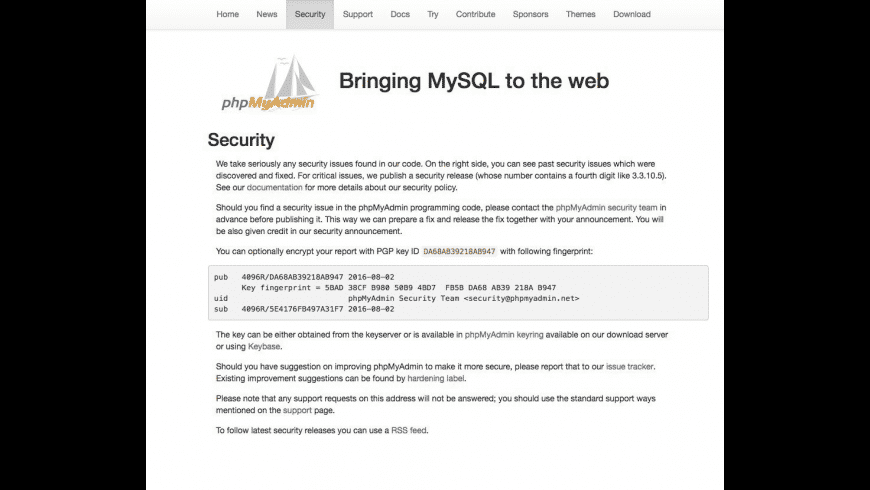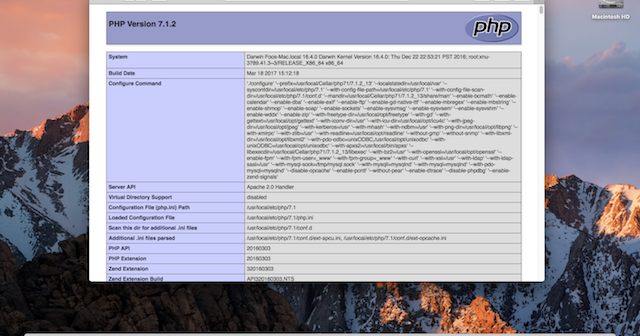- Phpmyadmin For Mac High Sierra
- Phpmyadmin For Mac Sierra Download
- Phpmyadmin For Mac Sierra 10
- Phpmyadmin For Mac Sierra Version
- Phpmyadmin
- Phpmyadmin For Mac Sierra Download
phpMyAdmin for MAC – This app was build by phpMyAdmin devel team and updated into the latest version at January, 26th 2019. Download phpMyAdmin 4.8.5 for Mac from Apps4MAC.com. 100% Safe and Secure ✔ Alows you to handle the administration of MySQL over the Web.
phpMyAdmin for Mac Download
phpMyAdmin for Mac – Download Free (2020 Latest Version). Alows you to handle the administration of MySQL over the Web. Before you download the .dmg file, here we go some fact about phpMyAdmin for Mac that maybe you want to need to know.
| App Name | phpMyAdmin for Mac App |
| File Size | 10.29 MB |
| Developer | phpMyAdmin devel team |
| Update | January, 26th 2019 |
| Version | phpMyAdmin 4.8.5 LATEST |
| Requirement | Mac OS X 10.1 or later |
Installing Apps on MAC

Most MacOS applications downloaded from outside the App Store come inside a DMG file. Like if you wanna download phpMyAdmin for Mac from this page, you’ll directly get the .dmg installation file into your MAC.
PhpMyAdmin 5.0.2. Released 2020-03-21, see release notes for details. Current version compatible with PHP 7.1 and newer and MySQL 5.5 and newer. How to install, start and test XAMPP on Mac OSX. Webucator provides instructor-led training to students throughout the US and Canada. We have trained over 90,000 students from over 16,000 organizations on technologies such as Microsoft ASP.NET, Microsoft Office, Azure, Windows, Java, Adobe, Python, SQL, JavaScript, Angular and much more.
- First, download the phpMyAdmin for Mac .dmg installation file from the official link on above
- Double-click the DMG file to open it, and you’ll see a Finder window.
- Often these will include the application itself, some form of arrow, and a shortcut to the Applications folder.
- Simply drag the application’s icon to your Applications folder
- And you’re done: the phpMyAdmin for Mac is now installed.
- When you’re done installing: just click the “Eject” arrow.
- Then you can feel free to delete the original DMG file: you don’t need it anymore.
- Now, enjoy phpMyAdmin for Mac !
You don’t have to put your programs in the Applications folder, though: they’ll run from anywhere. Some people create a “Games” directory, to keep games separate from other applications. But Applications is the most convenient place to put things, so we suggest you just put everything there.
DMG files are mounted by your system, like a sort of virtual hard drive. When you’re done installing the application, it’s a good idea to unmount the DMG in Finder.
Recommended app to install: Bluej for MAC Latest Version
Uninstall Apps on MAC
Removing phpMyAdmin for Mac apps is more than just moving them to the Trash — it’s completely uninstalling them. To completely uninstall a program on Mac you have to choose one of the options on below.
Method 1: Remove apps using Launchpad
Another manual way to delete phpMyAdmin for Mac apps from your Mac is using the Launchpad. Here’s how it works:
- Click Launchpad icon in your Mac’s Dock.
- Find the phpMyAdmin for Mac that you want to delete.
- Click and hold the phpMyAdmin for Mac icon’s until it starts shaking.
- Click X in the top-left corner of the app icon.
- Click Delete.
Method 2: Delete MAC apps with CleanMyMac X
Now it’s time for the safe and quick app uninstalling option. There’s a safest way to uninstall phpMyAdmin for Mac on Mac without searching all over your Mac, and that’s by using CleanMyMac X.
- Launch CleanMyMac X and click on Uninstaller in the left menu.
- Select the , you can either uninstall it or, if it’s not acting as it should, you can perform an Application Reset.
- Click on Uninstall or choose Application Reset at the top.
- Now that the application cleanup is complete, you can view a log of the removed items, or go back to your app list to uninstall more.
- And you’re done to remove phpMyAdmin for Mac from your MAC!
phpMyAdmin for Mac Related Apps
Here we go some list of an alternative/related app that you must try to install into your lovely MAC OSX
Disclaimer
This phpMyAdmin for Mac .dmg installation file is absolutely not hosted in our Hosting. When you click the “Download” button on this page, files will downloading directly in the owner sources Official Website. phpMyAdmin for Mac is definitely an app for MAC that developed by phpMyAdmin devel team Inc. We are not directly affiliated with them. All trademarks, registered trademarks, product names and business names or logos that talked about in right here are the property of their respective owners. We’re DMCA-compliant and gladly to cooperation with you.
To interact with MySQL by instead of using the command line, phpMyAdmin comes to the rescue, to get it running as part of your local development set up on OS X, a couple of steps need to be done. phpMyAdmin is a browser application that interacts with the underlying mysql data.
Phpmyadmin For Mac High Sierra
These steps will work on Mac OS X 10.9 Mavericks, OSX 10.8 Mountain Lion, 10.7 and 10.6 Snow Leopard.
Preparing for phpMyAdmin
Download the latest version now at version 4.something phpMyAdmin, the english.zip should be sufficient, after the file is downloaded unzip it and move it to your personal web sharing folder, this will either be “/Users/username/Sites” directory or other web root folder such as “/Library/WebServer/Documents/“.
Rename the folder from “phpMyAdmin-4.0.0-english” to “phpmyadmin“.
The rest of the tutorial assumes that you have already mysql set up with a mysql root user and password enabled if not then please follow that process first.
Phpmyadmin For Mac Sierra Download
The login address for phpMyAdmin is going to be http://localhost/~username/phpmyadmin/ or http://localhost/phpmyadmin/ depending on your web root directory, but before this will work correctly a few steps need to be done namely addressing the MySQL socket error and configuration file set up:
Phpmyadmin For Mac Sierra 10
a) Launch /Applications/Utilities/Terminal to fix the mysql 2002 socket error by entering the following commands:
Basically this is making an alias to where phpmyadmin thinks the mysql.sock is and where it actually is.

b) In the phpmyadmin folder in your web root make a new directory named “config”.
c) Give Others “write“permissions to the “/phpmyadmin/config” folder either through Get Info or a ‘chmod o+w‘ in Terminal.

Installing phpMyAdmin
Phpmyadmin For Mac Sierra Version
Older Safari browser currently has issues with the installation, blank screens?? Upgrade to Safari 6 or use either Chrome or Firefox.
Now we are ready to run the set up in the browser by going to:
http://localhost/~username/phpmyadmin/setup/
or
http://localhost/phpmyadmin/setup/
The new server to be configured is the localhost, click new server and then the only other configurations are the local mysql root user and the password in the Authentication tab.
Add in the username, by default “root” is assumed, add in the mysql root password (this is the password for mysql not for the OSX admin account) , click on save and you are returned to the previous screen.
Make sure you click on save, then a config.inc.php is now in the /config directory, move this file to the root level of /phpmyadmin and then remove the now empty /config directory.
Now going to http://localhost/~username/phpmyadmin/ or http://localhost/phpmyadmin/will now allow you to interact with your MySQL databases.
Phpmyadmin
Mcrypt missing extension – If your applications don’t require the mcrypt extension there is no need to worry about it missing as reported in phpMyAdmin, if you do need to install it follow the guide here on mcrypt extension in Mavericks.
Phpmyadmin For Mac Sierra Download
Upgrading phpMyAdmin is an easy task just grab the latest version from the phpmyadmin website and replace your older phpMyAdmin directory in your web shared folder apart from the “config.inc.php” file – make sure the config.inc.php is kept and put it back in the new directory.